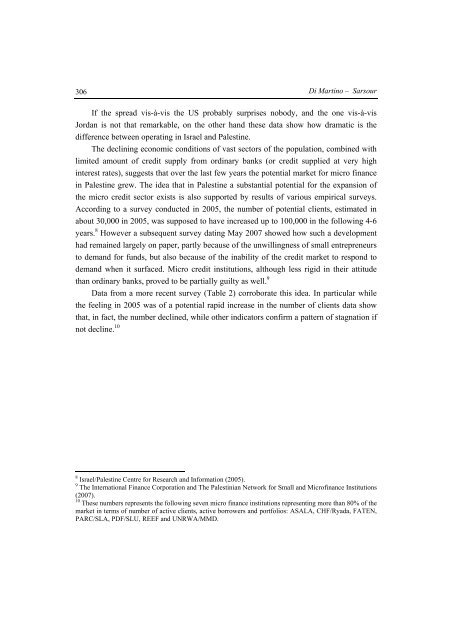The Palestinian Economy. Theoretical and Practical Challenges
The Palestinian Economy. Theoretical and Practical Challenges
The Palestinian Economy. Theoretical and Practical Challenges
Create successful ePaper yourself
Turn your PDF publications into a flip-book with our unique Google optimized e-Paper software.
306<br />
Di Martino – Sarsour<br />
If the spread vis-à-vis the US probably surprises nobody, <strong>and</strong> the one vis-à-vis<br />
Jordan is not that remarkable, on the other h<strong>and</strong> these data show how dramatic is the<br />
difference between operating in Israel <strong>and</strong> Palestine.<br />
<strong>The</strong> declining economic conditions of vast sectors of the population, combined with<br />
limited amount of credit supply from ordinary banks (or credit supplied at very high<br />
interest rates), suggests that over the last few years the potential market for micro finance<br />
in Palestine grew. <strong>The</strong> idea that in Palestine a substantial potential for the expansion of<br />
the micro credit sector exists is also supported by results of various empirical surveys.<br />
According to a survey conducted in 2005, the number of potential clients, estimated in<br />
about 30,000 in 2005, was supposed to have increased up to 100,000 in the following 4-6<br />
years. 8 However a subsequent survey dating May 2007 showed how such a development<br />
had remained largely on paper, partly because of the unwillingness of small entrepreneurs<br />
to dem<strong>and</strong> for funds, but also because of the inability of the credit market to respond to<br />
dem<strong>and</strong> when it surfaced. Micro credit institutions, although less rigid in their attitude<br />
than ordinary banks, proved to be partially guilty as well. 9<br />
Data from a more recent survey (Table 2) corroborate this idea. In particular while<br />
the feeling in 2005 was of a potential rapid increase in the number of clients data show<br />
that, in fact, the number declined, while other indicators confirm a pattern of stagnation if<br />
not decline. 10<br />
8 Israel/Palestine Centre for Research <strong>and</strong> Information (2005).<br />
9 <strong>The</strong> International Finance Corporation <strong>and</strong> <strong>The</strong> <strong>Palestinian</strong> Network for Small <strong>and</strong> Microfinance Institutions<br />
(2007).<br />
10 <strong>The</strong>se numbers represents the following seven micro finance institutions representing more than 80% of the<br />
market in terms of number of active clients, active borrowers <strong>and</strong> portfolios: ASALA, CHF/Ryada, FATEN,<br />
PARC/SLA, PDF/SLU, REEF <strong>and</strong> UNRWA/MMD.
















